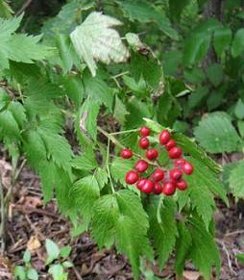Actaea
Actaea
(Plant heights are given at maturity)
Actaea sp. For plant information and cultivation instructions,
see PLANT INFORMATION AND CULTIVATION
below
 Red
Baneberry (Syn. Red Cohosh) - Actaea
rubrum - Perennial - Deeply cut green leaves and white
cylindrical blooms which mature to deep red berries in late summer
make this an eye catching addition to the shady flower garden.
PLANT WITH CAUTION AS BERRIES ARE HIGHLY TOXIC. Height: 24 inches
Hardy to -40F (-40C)
Red
Baneberry (Syn. Red Cohosh) - Actaea
rubrum - Perennial - Deeply cut green leaves and white
cylindrical blooms which mature to deep red berries in late summer
make this an eye catching addition to the shady flower garden.
PLANT WITH CAUTION AS BERRIES ARE HIGHLY TOXIC. Height: 24 inches
Hardy to -40F (-40C)
White Baneberry (Syn Doll's Eyes)
- Actaea alba (Syn. Actaea pachypoda) -
Perennial - Native to the Eastern US. White blooms and white
berries. PLANT WITH CAUTION AS BERRIES ARE HIGHLY TOXIC. Height:
24 inches, Spread: 36 inches Hardy to -40F (-40C)
PLANT INFORMATION AND
CULTIVATION
Actaeas are hardy herbaceous perennial plants
belonging to the Buttercup family, Ranunculaceae.
Growing about 18 to 30 inches high, they have pretty fern-like
leaves and spikes of small white blooms in spring, followed by
red, white or blue bitter berries which are poisonous - thus the
common name Baneberry. Native to North
America, Asia and Europe, they are found in shady or
semi-shaded areas. The plants thrive in ordinary soil with
leaf mold mixed in.
Propagation is easily done by sowing seed in a light
soil out of doors in early spring or when the seeds ripen in the
fall. Another method is plant division. Sow
seed in pots or trays 1/4 inch deep. Keep moist at
65F. Transplant seedlings when they reach 2 inches
tall. Transplant outdoors when all danger of frost has
passed. Space plants 12-18 inches apart each way.
Native Americans used the juice of the berries to poison
arrows. The poison acts on the cardiovascular system
producing erratic heart rhythm. The roots were also used medicinally
to treat stomach pains, coughs, colds
and menstrual irregularities. The roots are said
to be a violent purgative, causing severe vomiting.
Back to VARIETY INDEX
Terms HOME
 If you have
arrived in someone else's frame, or can not see all of the other
information available on richfarmgarden.com Click on logo to enter
from beginning
If you have
arrived in someone else's frame, or can not see all of the other
information available on richfarmgarden.com Click on logo to enter
from beginning
 Red
Baneberry (Syn. Red Cohosh) - Actaea
rubrum - Perennial - Deeply cut green leaves and white
cylindrical blooms which mature to deep red berries in late summer
make this an eye catching addition to the shady flower garden.
PLANT WITH CAUTION AS BERRIES ARE HIGHLY TOXIC. Height: 24 inches
Hardy to -40F (-40C)
Red
Baneberry (Syn. Red Cohosh) - Actaea
rubrum - Perennial - Deeply cut green leaves and white
cylindrical blooms which mature to deep red berries in late summer
make this an eye catching addition to the shady flower garden.
PLANT WITH CAUTION AS BERRIES ARE HIGHLY TOXIC. Height: 24 inches
Hardy to -40F (-40C)